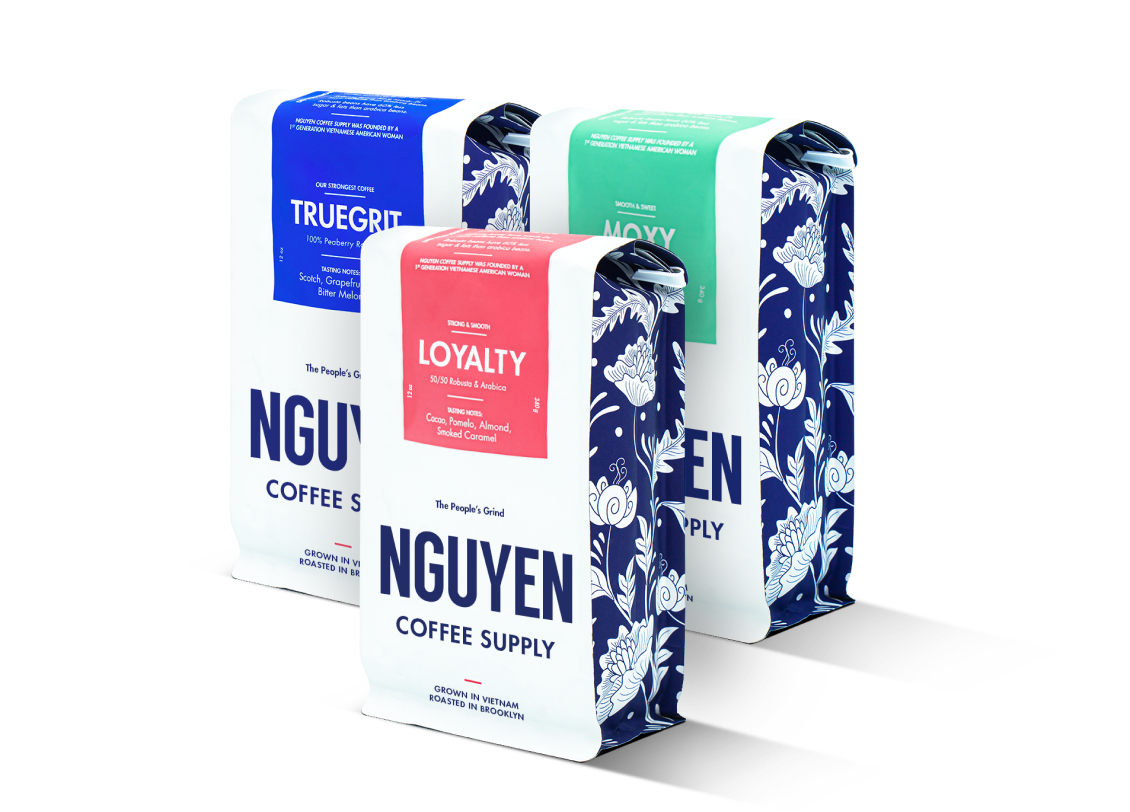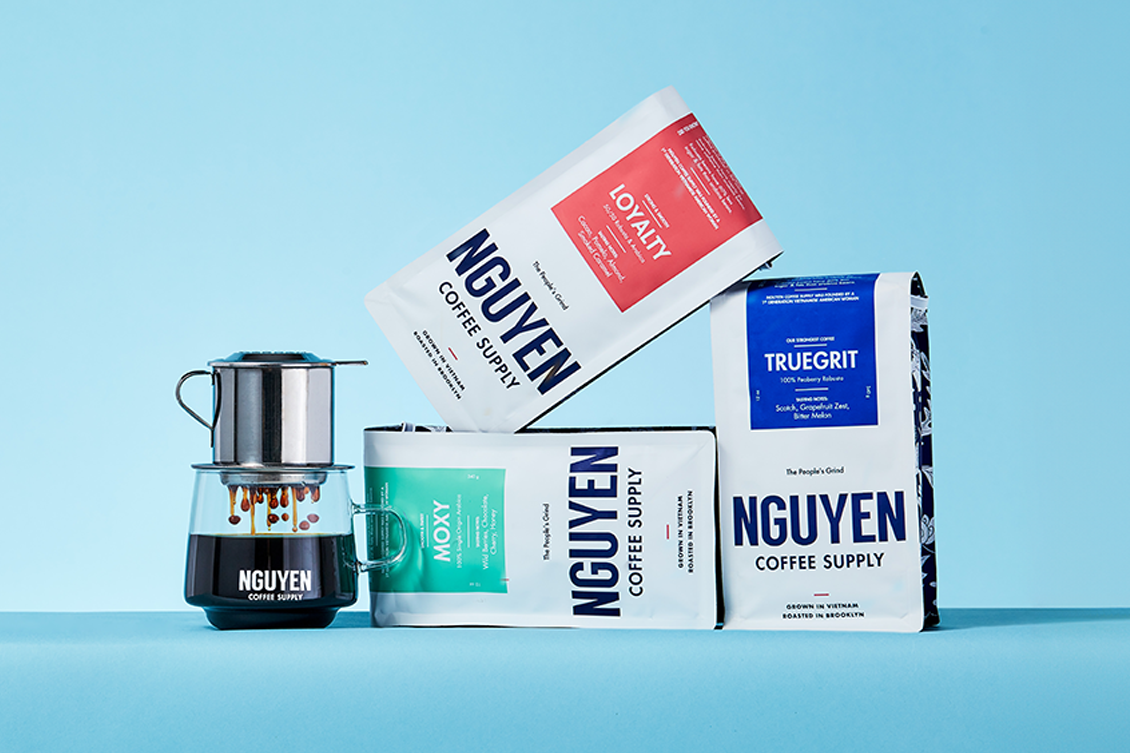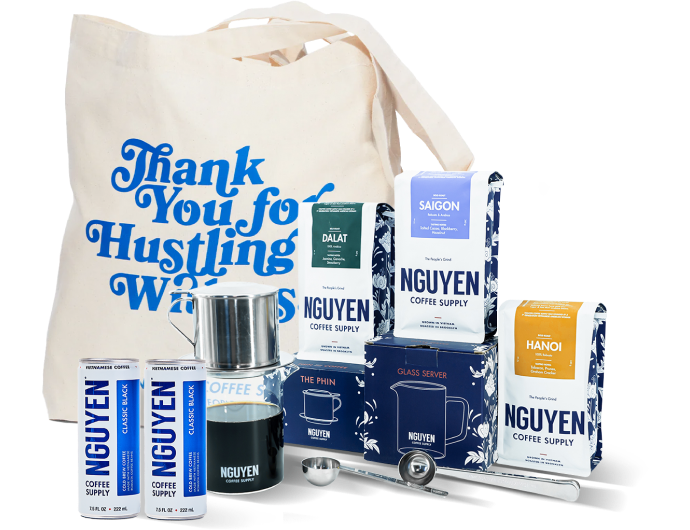

- FAN FAVORITE

Create for yourself or as a gift for your loved ones
Subscribe nowMe and mom just enjoyed the Nguyen phin drip experience. Wow. Proud of your work. We without hesitation enjoy the Vietnamese coffee and recommend your products. Thank-you to the Nguyen staff and tradition. From Canada eh!
Let’s talk about Vietnamese coffee. We’ll cover questions like how robusta beans are different from arabica beans, what exactly is Vietnamese coffee— all questions that will give us a better understanding of why Vietnamese coffee is so strong, bold, nutty, low-acidic & delicious!
What is Vietnamese Coffee?
Vietnamese coffee refers to coffee that is grown in Vietnam, the same as Colombian coffee refers to coffee grown in that country. The recent popularity of Vietnamese coffee culture might contribute to some people conflating sweetened condensed milk with Vietnamese coffee, however it’s important to note that while this is a popular style, people in Vietnam also enjoy Vietnamese coffee black. Some people may use coffee beans from other countries and call it “Vietnamese iced coffee,” however we believe in upholding the cultural and product integrity of Vietnamese coffee and supporting Vietnamese coffee farmers.
Vietnamese coffee is the most consumed in the world right after Brazilian coffee. The amount of coffee produced in both of these countries is massive, and within them are dozens of different beans.
Vietnam, in particular, has been experiencing a coffee revolution in the past few years. What was for many decades a quantity-driven market has shifted toward a quality-driven one as Vietnamese people have started appreciating specialty coffee more, and therefore valuing higher quality coffee. At Nguyen Coffee Supply, we are committed to helping more Vietnamese farmers enter specialty coffee, which means sustainable farming practices and economic empowerment.
Traditionally by Western standards, arabica beans are considered “superior” due to being higher quality and therefore most specialty coffees in America are of the arabica variant. However, higher quality production is simply a result of collective effort to improve farming practices and communities, not inherent to the variety of the coffee bean. Hence, Vietnamese specialty coffee includes both robusta and arabica, since we are committed to improving coffee farming and quality with all farmers, without discrimination to the type of bean they choose (or are able to) produce. More on the special relationship between Vietnam and robusta coffee in this next section:

Vietnam may be the second largest exporter of coffee, but when it comes to robusta, it is the number one producer of robusta, accounting for 70% of all robusta coffee produced and consumed worldwide. Most (around 90%) of all coffee grown in Vietnam is of the robusta variety.
There are two main varieties of coffee out there: robusta and arabica. It is the same genus, but each of these two is a completely different species. Even though robusta and arabica are of the same genus (coffea), they are still different in several respects. Here are some of their main differences:
But why does Vietnam produce so much more robusta than any other country? It all started with France. France had already acquired a taste for coffee that was rivaled only by Italy when it decided to annex Vietnam to its empire. In the middle of the 19th century, it colonized the country, and two decades later, it had a firm grip over all of Vietnam.
With the arrival of French people, French culture came along, and a big part of that was coffee which the French were not willing to sacrifice. Coffee was imported in droves, and plantations started appearing all over. But among all the French imports (bread, food, and so on), it was coffee that really captivated the hearts of Vietnamese people.
Coffee farming came naturally to the territory. There are only a handful of countries in the world with the right conditions to grow coffee (rightly called the Coffee Belt), and Vietnam is one of them. Robusta plants grow tall and luscious thanks to the climate and richness of the soil, particularly in the central highlands region, which is home to some of the most specialized farmers.
This region is known for its proficiency in farming, producing high-quality tea, rubber, and silk. It is also home to many of Vietnam’s ethnic minorities, as well as most of its wildlife. In other words: it's an area that is teeming with plant life, animal life, and has an old tradition of farmers that have long coexisted with the ecosystem.
To fully understand the importance of robusta coffee, it is key that we talk about caffeine. Over the years, coffee has evolved to become a beverage that we can enjoy solely because of its delicious taste. However, it might not have been like this all the time.
In fact, the early stories that tell of how coffee was discovered in Ethiopia centuries ago made it clear that if it wasn’t because of caffeine, we would have never discovered coffee. According to legends, a goat shepherd in Ethiopia had taken his goats out to pasture. He witnessed some of his goats munching on some nearby berries that he didn’t think were edible; after a few minutes, the goats were energetic, bouncing about, and playing with each other. It was then that he thought of trying some of the berries himself, and after feeling the effects of caffeine, decided to bring some back with him.
Many decades later, the first coffee drink made by roasting and grinding the seeds within those legendary beans would be born. And even though the aroma of coffee is powerful and sometimes even enough of a reward for brewing coffee, the truth of it is that coffee was mostly consumed because of caffeine.
Robusta Beans Deliver Double Caffeine
Nowadays, we as a society value caffeine greatly and heavily depend upon it. There is an ever-growing movement of coffee lovers that want more bang for their buck and turn to coffee such as robusta for a more caffeinated coffee that they can rely on. And it makes a lot of sense: arabica has half the caffeine and usually costs twice as much; robusta is generally more affordable than arabica, and it has a bold, robust taste that’s great for making beverages involving milk, cream, non-dairy options and sugars.
Another interesting fact here is that caffeine is everywhere. It is in most sodas, energy drinks, and even snacks– and it’s all derived and extracted from coffee beans! Whenever you want pure caffeine for putting into these products, there’s a few options—you can use arabica, which is costlier and less efficient, or you can use robusta beans.
The sole existence of cheap robusta beans guarantees natural, safe caffeine as an additive. Because the alternative would be artificial caffeine, which is still being researched and could be potentially bad for your health.
We mentioned before that coffee only grows in a handful of countries around the globe. These are mainly in Central and South America, Northern and Eastern Africa, and Southeast Asia. And even then, it only grows in high altitude and relatively temperate places within those countries.
Farming is a process that can potentially ruin the land it uses—depending on how frequently it is harvested and how many chemicals are used (and other more complicated factors).
Robusta has all the advantages when it comes to growing and sustainability. Remember how it has twice the amount of caffeine? Well, caffeine acts as a natural defense against both pests and disease. Arabica, on the other hand, is famously fragile to both of these. Tons (literally) of arabica beans are lost every year due to a disease called coffee leaf rust, which almost never afflicts robusta plants.
Then, there is the issue of the plant's resistance to both heat and cold. The main reason why coffee is not grown everywhere is because it only flourishes in temperate climates. Arabica, for example, only does well in temperatures around 21°C (69°F) with very small variations. It won’t do well in temperatures upwards of 24°C, for example.
Robusta, unlike arabica, can withstand much harsher temperatures. It can take temperatures as low as 10°C, and it grows easily in tropical climates which hover around 30°C. Many farmers grow them under the shade of other plants (like plantains) in even hotter climates, and it works.
Because they are different species, the robusta and arabica beans actually have quite a few differences when it comes to their appearance. With a little knowledge, you can tell them apart with a short inspection and know what kind of beans you’re really drinking.
For starters, robusta beans are smaller. They are about ¾ the size of typical arabica beans and also look more puffy, round almost in shape. By contrast, arabica beans have a more elliptical shape and look more elongated.
Then we have the slant in the middle: this is the most telling sign. Arabica beans will almost always have a snake-shaped slant, wavy. Robusta tends to have a straight line from start to finish.
Robusta has a distinct taste. It has more caffeine than any other type of coffee bean, offering a clean boost in energy.
In general, robusta coffee is described as being stronger, bolder, and as having a much higher presence of nutty flavor profiles. It is roasty and warm in both flavor and aroma. Arabica, on the other hand, frequently features bright acidity and fruit-like flavor notes.
A frequent question many people have is how long Vietnamese coffee lasts in their pantries. Well, the answer depends a lot on how you store your coffee.
Whole coffee beans already have quite a long shelf life. This is about six months after roasting by taking measures such as keeping them away from sunlight and storing them in a dry place in airtight conditions. There are coffee canisters in the market that do all the work for you and can help you keep your beans in top condition for almost a year.
Vietnamese coffee—robusta coffee specifically—still has a longer shelf life than arabica. This is because of the higher presence of antioxidants—which logically protect the beans against aging and deterioration. While there’s no agreement as to how much this affects the shelf life, we can assume it impacts it positively. Robusta beans, if stored properly, should last about one to two months longer than arabica beans. In fact, some people prefer older robusta beans as they find the flavors mature and develop even more deeply over time– like wine!
If stored in the fridge (inside a sealed container, preferably a coffee canister with a CO2 valve), they’ll last even longer. You can also store coffee in the freezer. Frozen beans can be good to drink for up to three years! That is, of course, as long as you freeze them in small packets. If you freeze them in bulk and take that same bulk out every time you brew coffee, you’re defrosting them on a daily basis, undoing all of the good that freezing them does.
There is no doubt that robusta’s strength is, redundantly enough, in its strength and boldness of flavor. However, we must take into account what our personal tastes are as an all-robusta espresso might not be for everyone.
We recommend that, if switching to robusta, experiment with different brew styles and coffee to water ratios, until you find the right recipe for you! Keep in mind that robusta has double the caffeine, so depending on your caffeine tolerance and preference, you may want to increase or decrease the water you use when making coffee. It’s all a fun experiment for personalization!
Recipes such as Vietnamese Iced Coffee and Vietnamese Egg Coffee are great ways to enjoy robusta coffee in traditional Vietnamese styles, using condensed milk as a sweetener to balance the coffee’s boldness and turn it into an impossibly delicious beverage.
Ultimately, when you consume Vietnamese coffee, you’ll be consuming something much stronger and much bolder than what you may find anywhere else!
You can also check out our guide to making coffee using a Phin filter (the traditional Vietnamese brewing method) which was specifically designed for brewing Vietnamese robusta beans. Cheers!